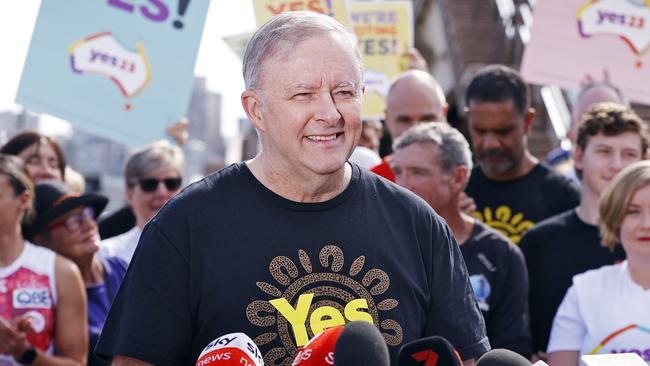
This is the message being signalled from the Prime Minister’s office, reflecting the high degree of political risk that still exists for Albanese.
There is an acute sense within senior ranks that the government must not allow its focus to be singularly consumed by the issue over the next six weeks.
With Jim Chalmers having spent last week flagging the economic storm clouds on the horizon, issues central to household concerns cannot be relegated to second position on the government’s agenda.
There remains a great uncertainty about the outcome and the unknowable political consequences of the result.
Despite what the polls have been suggesting up until now, either side can still win the debate.
Even the No campaign concedes there is a pathway to victory for the referendum to succeed.
Albanese can sense this and on Monday began recalibrating the message to diminish the significance of the voice as a way of allaying concerns among the undecideds.
Peter Dutton clearly also recognises this. The Liberal leader has shifted gear to one of caution, with a deliberate and considered message to voters that the race will be tight across the country.
This is a new development in the rhetorical debate. And it reflects a view that there has been a tendency to misread the polls, which can’t be assessed in the same way as election polling.
While the base vote of No is marginally stronger than the Yes case, there is not enough of a hard vote to say a negative result is a foregone conclusion.
This suggests that the No vote may not be as strong as it looks.
Dutton is obviously also concerned about complacency. He will be of the belief that regardless of what a forced outcome in a poll may look like, many people remain genuinely undecided.
One set of numbers being thrown around by the No camp is that they have around 30 per cent of the vote locked in, with 20 per cent locked into a Yes vote. This leaves 50 per cent up for grabs.
The pathway for Yes to win will be in its ability to tap into the soft vote with its significant campaign war chest.
However, it has to overcome a significant obstacle.
With cost-of-living pressures paramount in the minds of many Australians, the challenge will be to break through to people at all, let alone convince them.
There is a view shared by both camps that most voters are not focused on this debate.
How people react to the campaign that is about to be unleashed on them may very well determine which way it goes, with tens of millions of letters, texts and voicemails set to be sent out to every voter in the country, starting this week.
This will continue into the middle of October and may test the patience of many voters.




Anthony Albanese may be pushing the button on the voice referendum on Wednesday but don’t expect him to be out campaigning every day.